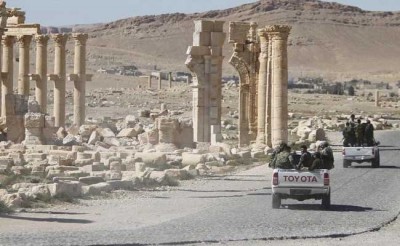Who Planned the Terrorist Operation in Palmyra?

The unexpected militant attack on Palmyra on Dec. 10 was an unpleasant revelation for everyone who expected IS/Daesh to quickly succumb after its stinging defeat in Aleppo. Around 5,000 terrorists overcame the resistance of smaller SAA contingent who were forced to withdraw toward the T4 airbase. Fortunately, 80% of the civilians had been successfully evacuated from Palmyra in time, but due to the presence of those remaining, the Russian air force could not be fully utilized to assail the positions of terrorists who had embedded themselves in residential neighborhoods.
More than anything else the attack was a serious blow aimed at Russia’s international image, as the world associates her with Palmyra after Valery Gergiev conducted an unforgettable concert there last May.
Unfortunately, the Syrian General Staff did not attach much importance to the skirmishes near the hilltop of Qasr al-Halabat southwest of Palmyra, Jabal Hayan in the western suburbs, South Sawamea to the northeast, and the Hawaisis region to the northwest, which took place on Dec. 9 and 10, and as a result the fighting advanced to within four kilometers of the city’s borders.
It is quite obvious that the terrorists had been trained in advance to capture the city. Back in late November, hundreds of armed infiltrators posing as civilians were secretly dispatched into Palmyra and at the appointed hour they ambushed the Syrian troops. Under cover of night, other ISIL detachments no less successfully managed to capture the poorly guarded vantage points and – simultaneously with the reinforcements arriving from Raqqa – attacked Assad’s forces that were guarding the city.
The total number of fighters taking part in the attack, as well as its timing, is clear evidence that this operation had been more carefully mapped out than is typical for terrorists, which suggests the existence of shadowy consultants working for Daesh. Not to mention the fact that the terrorists had unexpectedly acquired reserve personnel, high-end weaponry, tactical information, and specialized equipment.
The way the battle itself unfolded also seems suspicious. Despite heavy losses in manpower and equipment, the terrorists were focused and steady in their efforts to penetrate the residential areas of the city, without pausing to inflict bloodshed or collateral damage. This uncharacteristic behavior suggests that they had been drilled on the need to overtake the Syrian strongholds and make their way into the civilian neighborhoods prior to the arrival of the Russian air force.
Syrian intelligence obviously made a serious strategic miscalculation by failing to promptly warn the Russian military about 5,000 militants who traveled 220 kilometers along the highway between the “Caliphate” capital of Raqqa and Palmyra.
The militants came from a very specific and well-known location. In addition to Raqqa itself, they were redeployed from the region around Mosul, where the ongoing combat operations of the Iraqi forces controlled by the US and the international coalition came to an abrupt and obviously deliberate halt last week.
 In an astonishing coincidence, on Sunday Dec. 11 Pentagon Chief Ashton Carter arrived in Iraq for an unannounced visit to “assess progress in the fight to retake Mosul.” And it was announced on the eve of his visit that 200 additional US military personnel would be sent to Syria to “train” Syrian opposition groups. This brought the official number of US military advisors in Syria up to 500. Their primary task will be to ensure that the terrorist groups in Syria will be combat-ready during the “post-Aleppo” period.
In an astonishing coincidence, on Sunday Dec. 11 Pentagon Chief Ashton Carter arrived in Iraq for an unannounced visit to “assess progress in the fight to retake Mosul.” And it was announced on the eve of his visit that 200 additional US military personnel would be sent to Syria to “train” Syrian opposition groups. This brought the official number of US military advisors in Syria up to 500. Their primary task will be to ensure that the terrorist groups in Syria will be combat-ready during the “post-Aleppo” period.
Carter’s promise to liberate the Iraqi city before Donald Trump takes possession of the Oval Office on Jan. 20, 2017 is prompting the US military to make militants move out of Mosul into Syria. Thus a free corridor into Raqqa and onward to Palmyra has opened up for Mosul’s terrorists.
Clearly the most battle-hardened divisions of the Syrian army that are no longer fighting in Aleppo will be redeployed in the coming days in the direction of Palmyra, and the terrorists who find themselves trapped yet again will be systematically annihilated, accompanied by the insincere wails of the international media.
And because of what happened in Palmyra, the Russian military has now stated that Russia is no longer going to allow any kind of “humanitarian pause”:
The Daesh attack on Palmyra showed once again that terrorists should not have the slightest opportunity for a pause that they always use to regroup and deliver sudden strikes.
This is a signal to diplomats that they need to back off and allow the Russian MoD to impose some order and defeat wipe the Syrian terrorist groups. All the timeouts, which were intended to dampen the fever pitch of the anti-Russian rhetoric in the West, have already been used up.


